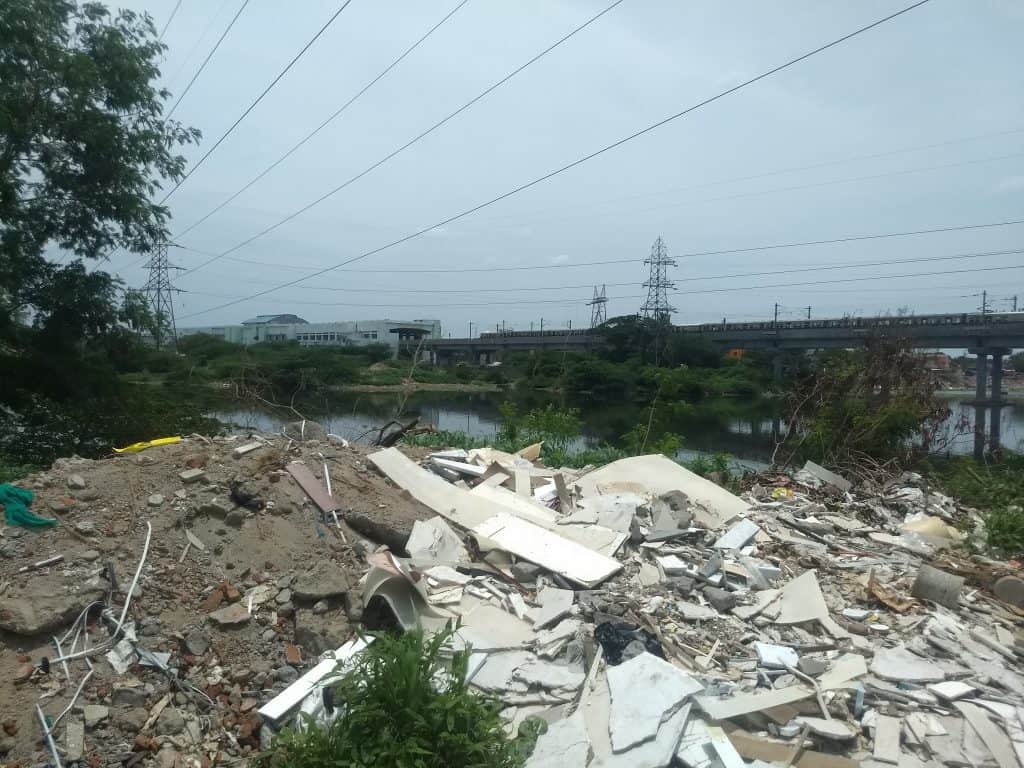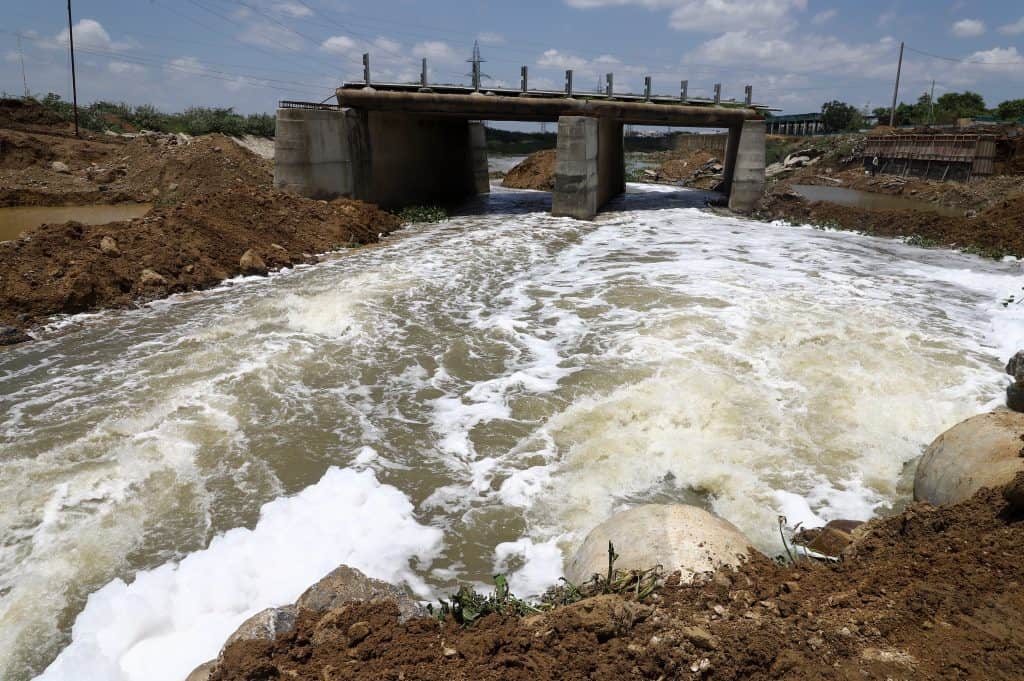It is a rough journey for the Adyar River as it flows from Adhanur village of Kancheepuram district to Chennai. At suburban Tambaram, the water body is greeted with a barrage of sewage that turns the muddy water pitch black. Further down at Tiruneermalai, heaps of biomedical waste are let into the waters. As it flows through Anakaputhur, industrial effluents pollute the water, leaving an unbearable stench. And at Kotturpuram, the river is almost walled in by construction material and solid waste thrown on its banks.
Dumping at Kotturpuram: Not a new story
The illegal dumping of construction waste is a silent killer at Kotturpuram. According to locals, lorries come during the wee hours and late nights to dump the rubble. “It all happens in a jiffy. The building waste dumped on the bund is slowly making its way into the river now,” said Kutty, who works as a security personnel on River View Road.
Pollution of the Adyar River has in fact worsened after a private builder, Appaswamy Builders, constructed a temporary mud road on the Adyar River bund. A total of 225 workers who work for the builder reside close to the bund and the access road was constructed to provide water for the workers, according to A Kumar (name changed), a worker.
A senior official at Appaswamy Builders confirmed the worker’s explanation that the road had been built to transport water to the 225 workers residing here. “We transport construction material to our site at Perungudi, where it is reused for filling. We do not pollute the river by any means — septic tanks clear the sewerage from the colony (where workers reside),” said the senior official, seeking anonymity.
However, environmentalists differ. “An access road or a ramp here is a violation in itself. Depositing waste on the bund is a byproduct of that violation,” said T D Babu, a marine biologist.
The tale is more or less the same in other parts of the Adyar River. This prominent waterway in the city is devastated by encroachment and disposal of solid waste and building waste which raises an important question: What is the Public Works Department (PWD), the custodian for water bodies up to? Why are the PWD workers not monitoring the Adyar River?
Efforts to get a response from the Chief Engineer of Public Works Department proved futile.
Road map to restoration
The poor state of affairs with respect to the Adyar River only accentuates the challenges for the Chennai River Restoration Trust, a nodal agency that is responsible for bringing the river back to life. Two years ago, the state government had sanctioned Rs 555 crore for the complete revival of the river. The total project cost of Adyar River Restoration is Rs 2047.02 Crore, according to the government order issued by the Municipal Administration and Water Supply department.
A fortnight ago, Tamil Nadu government also issued work orders to mitigate sewage flow into the arterial water bodies including the Adyar River at a cost of Rs 2,371 crores.
| Phase | Budget (in Rs) | Details |
| Short term (2016-18) | 1936.98 Crore | Resettlement and rehabilitation, restoration of 58 acres of Adyar Eco park |
| Medium term (2019-26) | 77.40 Crore | To restore 300 acres of creek, estuary, islets, mudflats and surrounding areas |
| Long term phase (2027-31) | 32.64 Crore | Riverfront development, River channel improvement and biodiversity management |
Source: CRRT
Restoration attempts are, however, visible in a few stretches. A see-through fence has been built in a few places, as CRRT officials confirmed that the work is in progress along a 18-km stretch of the river.
The challenges faced by CRRT are multi-fold. The short term revival, which is supposed to be completed by 2018, is hanging in the balance due to many factors, say officials. “Resettlement and rehabilitation can be done only after the end of the academic year. It is time consuming and sensitive,” said a senior official at CRRT. The project is getting delayed at the execution level. “A simple procedure of laying the pipelines to divert the sewage from the river is awaiting an approval from the Ministry of Environment, Forests and Climate Change (MoEFCC),” he explained.
Rays of hope
26 km of the total 42.5 km of the Adyar River is beyond the Greater Chennai Corporation premises, making it easy for restoration, say officials. According to them, the damage is comparatively less in the rural and semi urban areas. For example, at Chembarambakkam, birds flock to the Adyar River and thrive there. Eco-restoration of Adyar Creek and its conversion into a hub for interactive environmental education was a game changer, as it conveyed a silent message: The entire river — from the origin to the mouth — can be restored to a pristine water body.
Adyar River plays a major role in flood and drought mitigation for Chennai. “Hydro-geologically Adyar and Cooum rivers formed Chennai,” said J Saravanan, a water resource expert, “these rivers deposited substantial amounts of alluvium which makes for a good aquifer. Adyar is a major recharge source for the entire city. If you look at the old maps, you will notice how Long Tank connected Adyar and Cooum rivers, which resulted in water diversion. The Long Tank is dead now, thanks to rapid encroachments.”
Restoring rivers is a tall task anywhere, because of their vast geographical expanse and involvement of various line departments. But when the Jaipur’s largest sewer, Dravyavathi River is being renovated at such a fast pace and Germany’s Emscher river can be brought back to life, Adyar River could also perhaps join the list with more proactive government and citizen monitoring and action.
[Note: The article has been edited after it was first published on September 12, 2019]



I truly enjoy reading Laasya’s articles. They’re so informative and interesting to read. Keep up the good work. Continue doing the great job that you’re doing.
Good writeup, if the Adayar and coovam improves that will be a great thing for Chennai .Kindly highlight about gaps in civics,garbage disposal,Hygiene at Chennai.